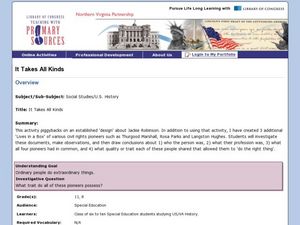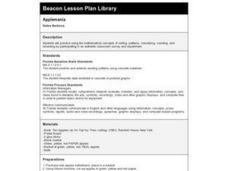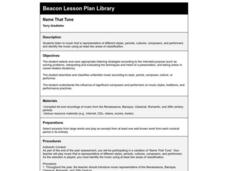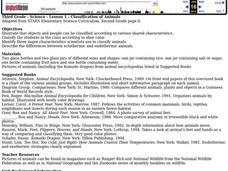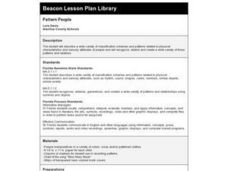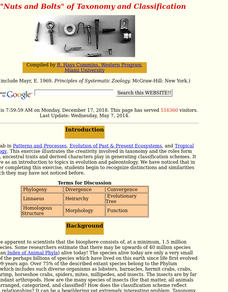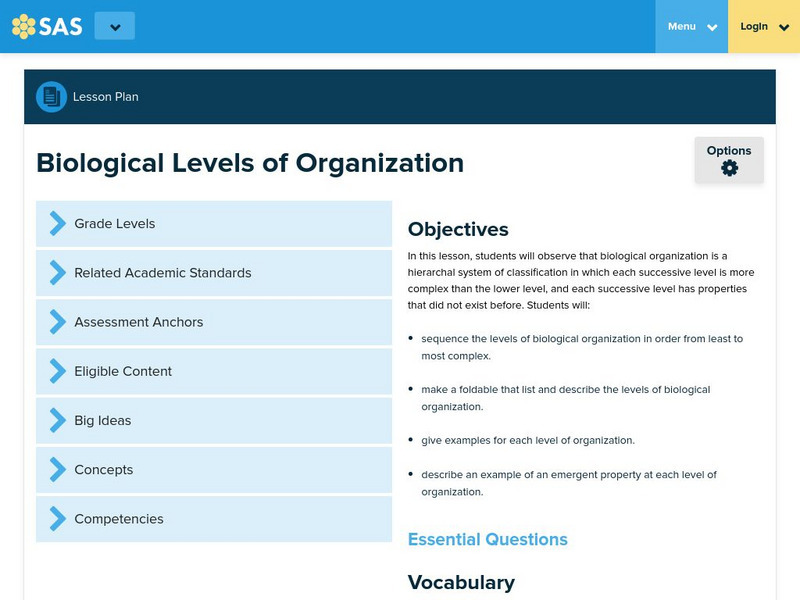Curated OER
Trees, Trees, Trees! - Adopt A Tree
Students adopt a tree, take a bark rubbing from that tree, and conduct research about that type of tree. They write an original piece about their tree using three facts and in a genre of their choice.
Curated OER
Lords of the Night
Second graders explore bird classification, specifically owls. They dissect their own owl pellet and explain the predetor and prey relationship.
Curated OER
It Takes All Kinds!
Students view video clips and observe similarities and differences between animals. They sort animals into groups for a zoo. They make a graph of their observations and review scientific classifications.
Curated OER
Physical Difference and Classification
Students use a microscope and observation skills to compare and contrast several physical properties and develop a classification system.
Curated OER
Applemania
First graders read "Ten Apples Up On Top!" and view real apples in a basket. They taste different kinds of apples and describe the tastes: sour, sweet, etc. They graph everyone's favorite apple. They interpret the graph and draw their...
Curated OER
Name That Tune
Fourth graders listen to different types of music, then categorize them into two different areas of classification.
Curated OER
Animals Galore
Third graders use structural characteristics to sort and classify animals into groups.
Curated OER
Classification of Animals
Third graders practice classiyfying items and identify three major characteristics scientists use to classify animals. They describe the differences between ectothermic and endothermic animals.
Curated OER
Sink or Float?
Students predict and explore to discover which objects sink or float in fresh and salt water, predict how salt affect objects, write predictions on T chart, discuss difference between man-made and natural waters, and graph results.
Curated OER
Pattern People
Students describe a wide variety of classification schemes and patterns related to physical characteristics and sensory attributes of people. They recognize, extend and create a wide variety of those patterns and relations.
Curated OER
Delicious Graphing
Fourth graders sort trail mix by type and use that information to create different types of graphs for comparing.
Curated OER
Science NetLinks: It Counts
Students explore how numbers are assigned to objects, as well as think about more, less, or equal values. They describe, compare, and classify plants.
Curated OER
The "Nuts and Bolts" of Taxonomy and Classification
Students develop classification scheme that meets the established rules of the Linnaean system. They write one page essay on classification choices.
Curated OER
To Classify Beans And Peas
First graders record information on a bar graph and interpret the information given. They identify five different kinds of beans and three different kinds of peas. They work in groups of four and sort the beans by size or shape.
City University of New York
Classification: Bringing Order Out of Chaos
A self-directed module on all aspects of biological classifications that covers the species problem, diversity and chaos, cladistics, putting things in groups, and so on.
University of California
Ucmp: Carl Linnaeus
This University of California Museum of Paleontology offers a very detailed biography of Carl Von Linne, also known as Carl Linnaeus.
Tree of Life Project
The Tree of Life Web Project
The Tree of Life Web Project contains information on living organisms including their history and characteristics. Over 3,000 web pages are linked together uniting all living things.
Other
Pennsylvania Doe: Lesson Plan: Biological Levels of Organization
A lesson plan that takes young scholars through the process of organizing a set of biological picture cards according to levels of complexity.
Alabama Learning Exchange
Alex: Let's Identify and Classify
During this hands-on instructional activity, students learn about scientific classification by navigating the Internet. They will examine a variety of potato chips in order to create their own classification key.
Ducksters
Ducksters: Biology for Kids: Scientific Classification
Kid's learn about Biological and Scientific Classification. Kingdoms, phylums, genus, species, and more.
Other
Secondary Science Program: The Six Kingdoms
A short overview of the six kingdoms in our scientific classification system: Plants, Animals, Protists, Fungi, Archaebacteria, and Eubacteria.




